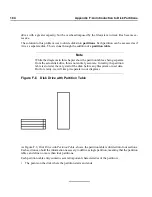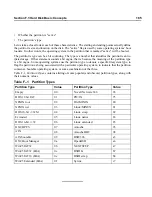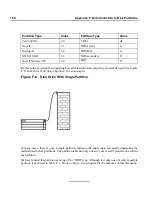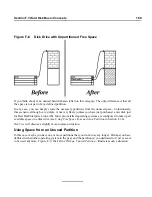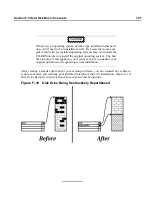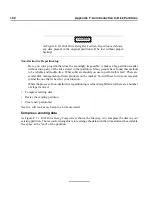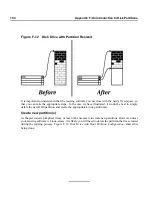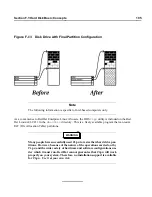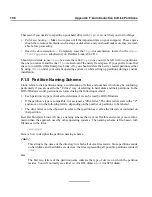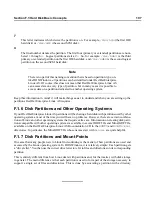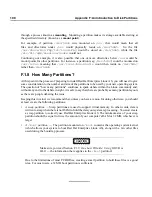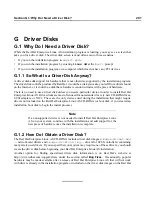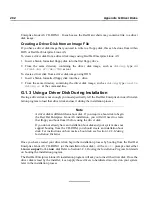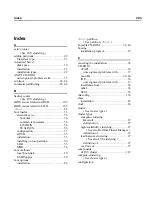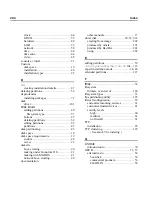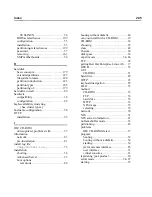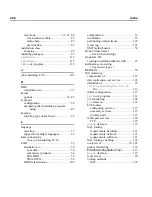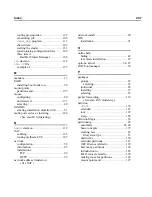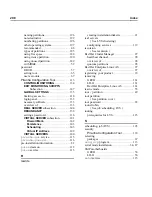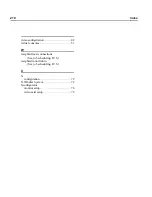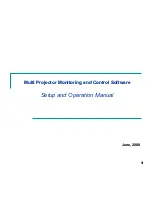
198
Appendix F:An Introduction to Disk Partitions
through a process known as mounting. Mounting a partition makes its storage available starting at
the specified directory (known as a mount point).
For example, if partition
/dev/hda5
were mounted on
/usr
, that would mean that all
files and directories under
/usr
would physically reside on
/dev/hda5
.
So the file
/usr/share/doc/FAQ/txt/Linux-FAQ
would be stored on
/dev/hda5
, while the file
/etc/X11/gdm/Sessions/Gnome
would not.
Continuing our example, it is also possible that one or more directories below
/usr
would be
mount points for other partitions. For instance, a partition (say,
/dev/hda7
) could be mounted on
/usr/local
, meaning that
/usr/local/man/whatis
would then reside on
/dev/hda7
rather than
/dev/hda5
.
F.1.8 How Many Partitions?
At this point in the process of preparing to install Red Hat Enterprise Linux AS, you will need to give
some consideration to the number and size of the partitions to be used by your new operating system.
The question of "how many partitions" continues to spark debate within the Linux community and,
without any end to the debate in sight, it is safe to say that there are probably as many partition layouts
as there are people debating the issue.
Keeping this in mind, we recommend that, unless you have a reason for doing otherwise, you should
at least create the following partitions:
•
A swap partition — Swap partitions are used to support virtual memory. In other words, data is
written to swap when there is not RAM to hold the data your system is processing. You must create
a swap partition to correctly use Red Hat Enterprise Linux AS. The minimum size of your swap
partition should be equal to twice the amount of your computer’s RAM or 32 MB, whichever is
larger.
•
A
/boot
partition — The partition mounted on
/boot
contains the operating system kernel
(which allows your system to boot Red Hat Enterprise Linux AS), along with a few other files
used during the bootstrap process.
CAUTION
Make sure you read Section F.1.9, One Last Wrinkle: Using GRUB or
LILO — the information there applies to the
/boot
partition!
Due to the limitations of most PC BIOSes, creating a small partition to hold these files is a good
idea. For most users, a 32 MB boot partition is sufficient.
Summary of Contents for ENTERPRISE LINUX AS 2.1 -
Page 1: ...Red Hat Enterprise Linux AS 2 1 The Official Red Hat Enterprise Linux AS Installation Guide ...
Page 8: ...viii ...
Page 14: ...xiv Introduction ...
Page 15: ...Part I Installing Red Hat Enterprise Linux AS ...
Page 16: ......
Page 26: ...26 Chapter 1 Steps to Get You Started ...
Page 30: ...30 Chapter 2 System Requirements Table ...
Page 80: ...80 Chapter 3 Installing Red Hat Enterprise Linux AS ...
Page 94: ...94 Chapter 4 Installing Red Hat Enterprise Linux AS via Text Mode ...
Page 95: ...Part II Configuring Red Hat Enterprise Linux AS ...
Page 96: ......
Page 100: ...100 Chapter 5 Introduction ...
Page 114: ...114 Chapter 6 Linux Virtual Server Overview ...
Page 153: ...Part III Appendixes ...
Page 154: ......
Page 156: ...156 Appendix A Additional Resources for LVS Clustering ...
Page 160: ...160 Appendix B A Sample etc sysconfig ha lvs cf File ...
Page 162: ...162 Appendix C Removing Red Hat Linux ...
Page 168: ...168 Appendix D Getting Technical Support ...
Page 178: ...178 Appendix E Troubleshooting Your Installation of Red Hat Enterprise Linux AS ...

